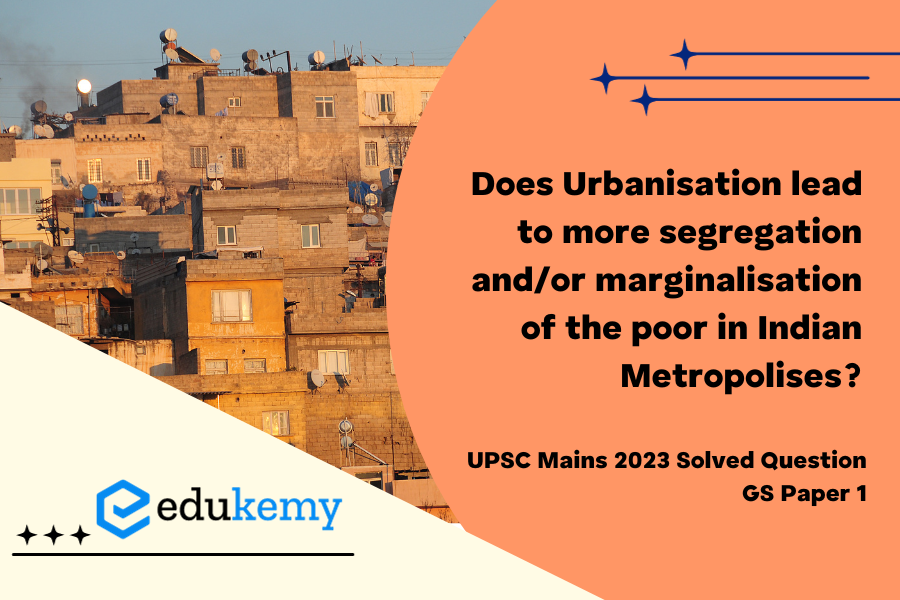UPSC Mains General Studies Paper – 1 Mains 2023
UPSC Mains Civil Services IAS Exam Question Paper – 2023
Contents
Introduction
Urbanisation primarily is an increasing shift of people from rural habitations to urban habitations. This shift is driven by growth of urban regions, increased propensity of urban quality of life, and enumeration based increase. According to the 2011 census, 31% of the population resides in urban areas and is speculated to rise to 50% by 2050.
Body
Urbanisation and Segregation of the Poor:
- Spatial Segregation: Urbanisation creates divisions between rich and poor areas, often pushing marginalised communities into substandard housing on city outskirts.
- Example: In Mumbai, rapid Urbanisation creates stark divisions. South Mumbai’s affluence sharply contrasts with the sprawling Dharavi slum, highlighting the rich-poor spatial divide.
- Limited Access to Services: Marginalised urban poor struggle to access basics like water, healthcare, and education, deepening socio-economic gaps.
- Example: Delhi’s unauthorised colonies struggle with inadequate infrastructure, limiting Marginalised residents’ access to clean water and healthcare, deepening socio-economic disparities.
- Informal Employment: Many urban poor work in insecure, low-paying jobs, leaving them economically vulnerable and socially excluded.
- Example: Kolkata’s urban poor often resort to insecure, low-paying jobs like street vending and rickshaw pulling, sustaining economic vulnerability and social exclusion.
- Social Exclusion: Discrimination based on factors like caste or religion worsens marginalisation, affecting housing, education, employment, and civic participation.
- Example: Chennai grapples with caste-based discrimination, impacting housing, education, and job prospects for marginalised groups like the Dalits, intensifying social exclusion.

Urbanisation and Marginalisation of the Poor:
- Land Displacement: Urbanisation often displaces poor communities, causing homelessness and increased vulnerability.
- Example: In Bengaluru, rapid urbanisation and land acquisition displace slum dwellers, leaving them homeless and economically vulnerable.
- Income Inequality: Rapid urbanisation can widen income disparities, leading to poverty traps and social unrest among the poor.
- Example: In Gurugram, Haryana, economic growth widens the gap between high-income IT professionals and low-wage Laboure’s, posing social unrest risks.
- Healthcare Gaps: Limited healthcare access in slums results in health disparities and higher mortality rates.
- Example: In Chennai’s slums, limited access to quality healthcare leads to higher disease prevalence and infant mortality among the urban poor.
- Education Challenges: Despite urban schools, poor children face barriers like financial constraints and inadequate infrastructure.
- Example: In Mumbai’s Dharavi settlements, inadequate infrastructure and financial constraints hinder quality education access, perpetuating disparities among urban poor children.
| Case study– Pandemic saw wide swathes of Laboure’s returning to their native villages from the cities and unveiled existing inequalities. Most of them identified in the category of ‘urban poor’. |
Conclusion
Hence, Inadequacy of urban infrastructure-physically and economically to sustain its workforce was very much evident. If coupled with appropriate in demand skill set However, if coupled with appropriate-in demand skill sets and state support through schemes like AMRUT, PM AWAS, PM-KVY, etc. the marginalised can be assured a life of dignity essential for sustainable and inclusive growth.
In case you still have your doubts, contact us on 9811333901.
For UPSC Prelims Resources, Click here
For Daily Updates and Study Material:
Join our Telegram Channel – Edukemy for IAS
- 1. Learn through Videos – here
- 2. Be Exam Ready by Practicing Daily MCQs – here
- 3. Daily Newsletter – Get all your Current Affairs Covered – here
- 4. Mains Answer Writing Practice – here


